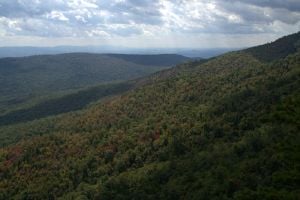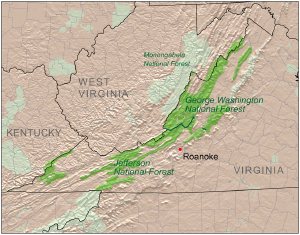Difference between revisions of "George Washington and Jefferson National Forests" - New World Encyclopedia
Vicki Phelps (talk | contribs) |
Vicki Phelps (talk | contribs) |
||
| Line 34: | Line 34: | ||
==Flora and fauna== | ==Flora and fauna== | ||
| − | There are over 500 species of | + | There are over 500 species of [[tree]]s and [[plant]]s and the [[forest]] is dominated by various species of [[oak]]s and [[hickory|hickories]], with [[maple]]s and [[pine]]s also common. The [[American black bear|black bear]] is common enough that there is a short hunting season to prevent overpopulation. White-tailed [[deer]], [[bobcat]], [[bald eagle]]s, [[weasel]], [[otter]], and [[marten]] are also known to inhabit the forest. |
==Activities== | ==Activities== | ||
Revision as of 14:46, 29 October 2008
| George Washington and Jefferson National Forests | |
|---|---|
| IUCN Category VI (Managed Resource Protected Area) | |
| | |
| Location: | Virginia, West Virginia, & Kentucky, USA |
| Nearest city: | Roanoke, VA |
| Area: | 1,788,739 acres (7,238.77 km²) |
| Established: | 1995 |
| Governing body: | U.S. Forest Service |
The George Washington and Jefferson National Forests are U.S. National Forests that combine to form one of the largest areas of public land in the Eastern United States. They cover 1.8 million acres (7,300 km²) of land in the Appalachian Mountains of Virginia, West Virginia, and Kentucky. The forest extends along the entire length of the Blue Ridge Mountains and the Alleghany Mountains to the North Carolina border. Just over one third of the forest is actively used for timber harvesting, with the bulk of that used for furniture manufacturing and pulp for paper products. Approximately one million acres (4,000 km²) of the forest are remote and undeveloped and 89,862 acres (363.66 km²) have been designated as wilderness areas, which eliminates future development.
George Washington National Forest was established on May 16, 1918 as Shenandoah National Forest. On June 28, 1936 the name was changed to George Washington, and on July 22, 1933 Natural Bridge National Forest was added. Jefferson National Forest was established on April 21, 1936 from parts of Unaka National Forest, George Washington, and other lands.[1] The two forests were administratively combined in 1995. North of the James River the forest is called George Washington National Forest. South of the James River it is called Jefferson National Forest. Forest headquarters are located in Roanoke, Virginia.
Notable features
- The northern portion of the Blue Ridge Parkway which is separately administered by the National Park Service runs through the Forest.
- Over 2,000 miles (3,000 km) of hiking trails go through the forest.
- Virginia's highest point, Mount Rogers, is located in the Mount Rogers National Recreation Area that is part of the forest. Other notable mountains include Elliott Knob which has one of the last remaining fire lookout towers in the eastern U.S. and White Top Mountain.
Flora and fauna
There are over 500 species of trees and plants and the forest is dominated by various species of oaks and hickories, with maples and pines also common. The black bear is common enough that there is a short hunting season to prevent overpopulation. White-tailed deer, bobcat, bald eagles, weasel, otter, and marten are also known to inhabit the forest.
Activities
The forests are popular hiking, mountain biking, and hunting destinations. The Appalachian Trail extends for 330 miles (530 km) from the southern end of Shenandoah National Park through the forest and along the Blue Ridge Parkway. The forest is within a two hour drive to over 10 million people and receives heavy visitation, especially in the region closest to Shenandoah National Park.
The George Washington National Forest is a popular destination for trail runners. It is the location for several Ultramarathons, including the Massanutten Mountain Trails 100 miler, the Old Dominion 100 miler, and the Old Dominion Memorial 100 miler[2].
Counties
Counties are listed in descending order of forestland area within county. Note that Jefferson National Forest is located in 22 separate counties, more than any other National Forest except Mark Twain National Forest in Missouri, which lies in 29 counties. Note also that Botetourt, Monroe, and Rockbridge counties, at the dividing line between the two forests, include parts of both forests. Thirdly, note that the state of Kentucky actually has very little acreage, with its two counties bringing up the tail end of Jefferson National Forest. As of September 30, 2007 George Washington National Forest has a total area of 1,065,389 acres (1,664.7 sq mi, or 4,311.5 km²). There are local ranger district offices located in Bridgewater, Covington, Edinburg, Hot Springs, and Staunton. Jefferson National Forest has a total area of 723,350 acres (1,130.2 sq mi, or 2,927.3 km²). [1] There are local ranger district offices located in Blacksburg, Marion, Natural Bridge, New Castle, and Wise.
George Washington National Forest
- Augusta County, Virginia
- Bath County, Virginia
- Alleghany County, Virginia
- Rockingham County, Virginia
- Shenandoah County, Virginia
- Highland County, Virginia
- Amherst County, Virginia
- Hardy County, West Virginia
- Pendleton County, West Virginia
- Rockbridge County, Virginia
- Page County, Virginia
- Nelson County, Virginia
- Botetourt County, Virginia
- Warren County, Virginia
- Frederick County, Virginia
- Hampshire County, West Virginia
- Monroe County, West Virginia
Jefferson National Forest
- Craig County, Virginia
- Bland County, Virginia
- Smyth County, Virginia
- Botetourt County, Virginia
- Giles County, Virginia
- Wythe County, Virginia
- Wise County, Virginia
- Scott County, Virginia
- Grayson County, Virginia
- Washington County, Virginia
- Rockbridge County, Virginia
- Montgomery County, Virginia
- Pulaski County, Virginia
- Bedford County, Virginia
- Monroe County, West Virginia
- Lee County, Virginia
- Tazewell County, Virginia
- Dickenson County, Virginia
- Carroll County, Virginia
- Roanoke County, Virginia
- Letcher County, Kentucky
- Pike County, Kentucky
ReferencesISBN links support NWE through referral fees
- ↑ Davis, Richard C. (September 29, 2005),
 PDF, The Forest History Society
PDF, The Forest History Society
- ↑ Run100s ("Run Hundreds") - A Not-For-Profit UltraRunning Corporation
“Prehistoric Southwest Virginia: Aboriginal Occupation, Land Use, and Environmental Worldview,” Smithfield Review 5 (April 2000): 125-151.
“Turnpike Tourism in Western Virginia,” Virginia Cavalcade 48:1 (Winter 1998): 14-23.
“The Potts Valley Branch Railroad and Tri-State Incline Lumber Operation in West Virginia and Virginia, 1892-1932,” West Virginia History 54 (1995): 42-58.
“The Mount Rogers National Recreation Area and the Rise of Public Involvement in Forest Service Planning,” Environmental History Review 28 (Summer 1994): 41-65.
“An Appalachian Forest: Creation of the Jefferson National Forest and its Effects on the Local Community,” Forest and Conservation History 37:4 (October 1993): 169-178.
“The Great Anti-Fire Campaign,” American Forests, 99:5&6 (May/June 1993): 33-35, 58.
“Green Cove Station: An Appalachian Train Depot and Its Community,” Virginia Cavalcade, 42:2 (Autumn 1992): 52-61.
“Fisheries and Wildlife Management: Part of the History of the Jefferson National Forest,” Virginia Forests, 48:2 (Summer 1992): 6-8.
External links
Credits
New World Encyclopedia writers and editors rewrote and completed the Wikipedia article in accordance with New World Encyclopedia standards. This article abides by terms of the Creative Commons CC-by-sa 3.0 License (CC-by-sa), which may be used and disseminated with proper attribution. Credit is due under the terms of this license that can reference both the New World Encyclopedia contributors and the selfless volunteer contributors of the Wikimedia Foundation. To cite this article click here for a list of acceptable citing formats.The history of earlier contributions by wikipedians is accessible to researchers here:
The history of this article since it was imported to New World Encyclopedia:
Note: Some restrictions may apply to use of individual images which are separately licensed.



